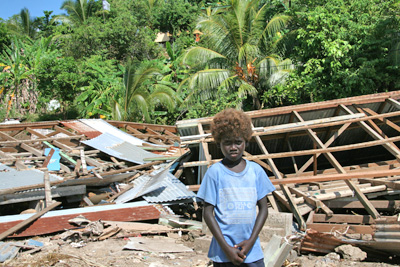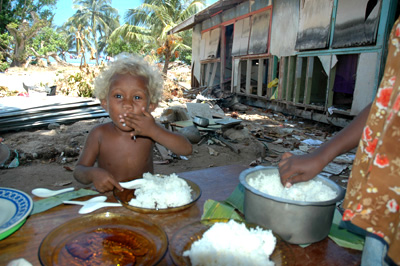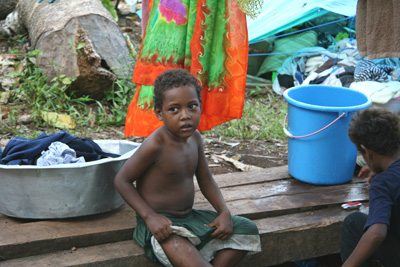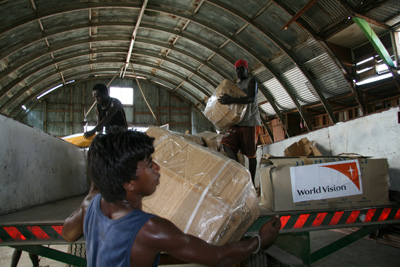
DAVID ADAMS reports on the challenges now facing the Solomon Islanders in the wake of the tsunami...
It’s two weeks since a deadly earthquake shook the Solomon Islands but for those helping with relief efforts, the work has only just begun.
The tsunami, which was reported as causing a surge of water as high as five metres in some places, was the result of an earthquake, measuring as high as 8.0 on the Richter scale, which occurred at 7.40am on 2nd April on the seabed about 45 kilometres off the coast of the island of Gizo, in the west of the Solomon Islands.
Latest figures show that as many as 52 people have now perished as a result of the tsunami but officials now say they don’t expect it to significantly rise further.


Top: The utter devastation on the Island of Gizo. A boy stands out the front of his home that has been totally destroyed. Bottom: A child on the island of Gizo surrounded by the destruction caused by the tsunami. Aid supplies including food such as rice are now streaming into the area. PICTURES: Martin Thomas (World Vision)
As many as 6,000 people were made homeless in the disaster and it’s suggested that tens of thousands more have been affected through such things as the loss of their livelihood. Many of those affected are children with more than 40 per cent of the population aged under 15.
Kevin Rietveld, an Australian missionary who has lived with his wife Machi in the Solomon Islands since 1998, says the disaster caught people unawares.
“The big one came quite early, and in many places, the water surged away from the shore at first, exposing reefs,” says Rietveld, who was sent by the Christian Reformed Churches of Australia to the Solomons where he and his wife run Short Workshops in Mission, an organisation based on the outskirts of the capital Honiara which was created to support Christian churches and communities in the islands.
“Many people, not realising what was happening, went to see what was happening, even to pick up floundering fish. Because it was the beginning of Holy Week (celebrated by many churches), services were being held in churches at that hour of the morning. When the tsunami surged in, many people were caught off guard. People were swept out to sea, others were swept inland, others had buildings collapse on or around them.”
Martin Thomas was part of World Vision Australia’s initial assessment team that went to the Solomons in the wake of the disaster.
Thomas, who is the organisation’s Sydney-based media director, spent five days in the Solomon Islands – largely in Gizo, one of islands in the nation’s west which bore the brunt of the recent tsunami – before returning to Australia late last week.
“It is amazing what power the water must have had,” he says. “Certainly in some of these villages, the structures were quite primitive – they were bamboo or wood with leaves on the roof – and they were totally destroyed.
“But there was also a large number of concrete buildings and in many cases you would see concrete foundations standing by themselves and you’d have to look around and it was a good 30 metres away where you’d see three rest of the house, the rest of the structure. There are quite dramatic pictures of corrugated iron wrapped around trees and that sort of stuff. So it was certainly savage.”
Thomas says that he believes one of the big differences between the Asian tsunami of Boxing Day, 2004, and that off the coast of the Solomons relates to the topography of the islands.
“So it looks like the wave had decimated the villages at sea level but then whacked into the hillside and receded whereas in Aceh, if you remember those images, there was a much more flat topography…so there certainly was not the widespread destruction.”
Gizo is just one of about 300 islands in the nation’s western province, which is home to some 90,000 people, almost a fifth of the nation’s total population.
“It gives you some idea of the logistics of trying to assess such a place,” Thomas says. “Certainly some of the initial complications (in responding to the disaster were caused by) the fact that traditionally they get around by boat and most of the boats were destroyed in the tsunami. There are some limited roads but a lot of those were destroyed.”
Thomas, meanwhile, notes that the presence of the Regional Assistance Mission to the Solomon Islands (RAMSI), an Australian-led multinational force which came to the Solomon Islands in 2003 charged with restoring peace and disarming ethnic militias, in the area had helped by providing equipment such as helicopters to assess the damage and reach outlying areas with initial aid.
“There were reports of tensions between government officials and various Australian officials, but from our end, what we saw on the ground, the co-ordination was excellent.”
“It is amazing what power the water must have had…(I)n many cases you would see concrete foundations standing by themselves and you’d have to look around and it was a good 30 metres away where you’d see three rest of the house, the rest of the structure.”
– Martin Thomas, World Vision
Thomas says that initial efforts to assess damage and reach people in the wake of the tsunami were also hampered by the fact that there were up to as many as 60 aftershocks in the two or three days following the initial earthquake.
“That certainly kept people fearful,” he says. “A lot of the people essentially ran to higher ground and set up makeshift camps. Most of their villages, particularly those right on the ocean were destroyed, and they were very fearful of coming down again. Some of these, not all were fishing villages, and so their source of food and livelihood was severely disrupted and I think it’s going to be quite a long process to convince them to come down again.”
Thomas says that in the immediate aftermath of the tsunami Gizo was described as being “almost like a ghost town”.
“The markets were shut because no one was travelling from these outer islands to bring produce in; most of the stores were shut down. It’s affected people’s lives quite dramatically.”
But he says that by mid last week shops had already started to reopen. “There’s some early signs of life returning to some level of normality.”
Thomas says the immediate threat in the aftermath of the tsunami concerned the spread of diseases such as diarrhoea and dysentery.
“These people have gone from their normal villages into makeshift camps,” he says. “The camps are fairly crowded in the hills and they don’t have access to their natural water sources so potentially they’re accessing dirty and contaminated water.”
World Vision are operating as many as nine camps with up to 1,000 people in each.
Aid experts have warned that there may also be issues with people’s nutrition given the devastation wrought on people’s vegetable gardens and the fact that people have stopped fishing.
These issues are further exacerbated by the ongoing issues with poverty in the Solomon Islands.
“Right across the Solomons, malnutrition levels are high, immunisation rates are quite low…” says Thomas. “It is a poor country and it has…a very high proportion of people who we would deem to be in poverty.


Top: A child in a makeshift camp near the village of Titianna. The village was destroyed by the tsunami a-villages set up camp on the nearby hills but wi-little access to fresh water a-overcrowding there have been fears of the spread of disease. Bottom: World Vision supplies being unloaded in Gizo. The relief supplies included tarpolins a-rope to help people set up shelter as well as food-water a-emergency kits wi-basic sanitation products a-cooking utensils. PICTURES: Martin Thomas (World Vision)
“What we’ve also found is that when you get poor communities, they aren’t as resilient as other communities when they are subject to a natural disaster – they can’t respond in the same way…”
“People who are essentially subsisting through a meal at a time, as soon as there is a shock to their environment, they are very much more vulnerable to disease and malnutrition.”
The nation’s National Disaster Council has already moved onto the second stage of its response plan which, as well as preventing disease, also means considering sanitation issues, the provision of household necessities and repairs to repairs to roads, wharves and other infrastructure. Longer term, issues such as the resettlement of villages will need to be addressed.
Rietveld, whose wife Machi is now assisting the National Disaster Council in their work, says that while churches have played an important role in responding to the disaster, there are lessons to be learned in greater co-ordination of efforts.
“The churches have rallied in prayer, chartered ships to send relief goods, sent key people to do assessments, counselling and comfort the bereaved,” he says.
“They have, however, worked independently from each other. Even though there is an umbrella organisation called SICA (Solomon Islands Christian Association) which has also launched an appeal, the churches have not linked in to it. Neither have they made their plans known to the NDC (National Disaster Council), and the NDC has had to chase them to get relevant information.”
Asked what Christians should be praying for with regard to the disaster, Rietveld’s list includes that people pray the relief be “fairly and equitably distributed to where the needs are”.
“Pray that greed and selfishness may be kept at bay in a culture where people look for handouts,” he says. “Pray that no unscrupulous collectors may pocket people’s well meant gifts. Above all, pray that people may learn from these signs of the times and renew their relationship with Christ, and so be prepared for his coming.”
There have been some positive stories coming out of the disaster. Rietveld tells of two young men who were holidaying in a village and, aware of what was happening, alerted the villagers to run to safety.
“One of them ran back into the village to pick up a disabled child and carried her to safety,” he says. “Pure bravery.”
Another young man by the name of John in was out about 500 metres in his canoe near Kolombangara Island when he felt the quake.
“He turned to go back, was carried in by the first small wave,” says Rietveld. “Then as the tide surged out, he remembered what his father had once told him about tsunamis, and he raced back to alert and evacuate the whole village. No one was injured there.”
He adds that in the wake of the disaster, “many people have donated generously, and many have volunteered their services selflessly”.
“For all this, we thank God.”
World Vision has launched the Solomon Islands Disaster Appeal to help those affected by the quake and tsunami. To donate contact World Vision on 13 32 40 or www.worldvision.com.au.





